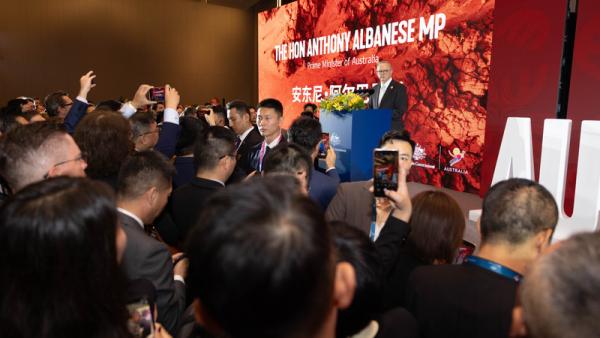Australia-China: Where to now?
DFAT

Elena Collinson, Manager, Research Analysis, Australia-China Relations Institute, University of Technology Sydney |
This article appeared in 9DASHLINE on December 14 2023.
After seven years marked by bullying and heavy-handed tactics by Beijing, episodes of diplomatic inelegance by Canberra, and the asperity of mutual criticism, Australia-China relations have tentatively shifted to a more normalised state.
This was exemplified by Australian Prime Minister Anthony Albanese’s visit to China in November 2023, meeting President Xi Jinping and other senior members of the Chinese leadership. Albanese and Xi issued a statement on joint outcomes, which placed a floor of sorts under the bilateral relationship. The question now is whether this newfound civility can translate to much beyond a delicate rapprochement.
The state of play
The bilateral relationship had been under strain since late 2016, with difficulties becoming particularly acute during the COVID-19 pandemic. In April 2020, the Australian government called for an independent, international inquiry into the origins and spread of COVID-19, honing in on China’s response to the virus, with then Prime Minister Scott Morrison pushing at the same time for ‘weapons-inspector’-like powers to be given to the World Health Organisation. This was followed by a steady stream of economic punishment meted out by Beijing from May 2020, targeting Australian exports such as barley, wine, coal, timber, lobster, cotton, education, and more.
In July 2021, the Chinese Foreign Ministry acknowledged that Beijing was wielding the economic relationship with Australia as a tool to communicate political dissatisfaction. High-level dialogue between the nations was frozen, despite some attempts by Canberra to restart talks, and references by either side to the countries’ comprehensive strategic partnership effectively disappeared from political rhetoric. Beijing also appeared to target Australian citizens as political tensions simmered, detaining Yang Hengjun and Cheng Lei. Australian representatives described their cases as arbitrary detention.
Since the Labor government’s victory at the Australian federal election in May 2022, however, both nations have worked to move relations to a more even footing. High-level political exchange is back in full flight and there has been notable improvement on the bilateral trade front. China lifted its tariffs of 80.5 percent on Australian barley with Australia in parallel discontinuing its legal proceedings on the matter at the World Trade Organisation (WTO). It also returned Australia to its Approved Destination Status list, permitting the resumption of group tours, and allowed Australian timber back after having subjected it to informal restrictions.
Most recently, Beijing agreed to commence a five-month review of its tariffs of up to 220 percent on Australian wine, with Australia agreeing to suspend its WTO case on the matter while the review is underway. Australia’s Anti-Dumping Commission around the same time made a preliminary recommendation to allow tariffs on China-made wind towers to expire in April next year, one of the goods categories that China is currently disputing at the WTO.
Other points of friction have also been addressed. Cheng Lei, an Australian citizen who had been detained for more than three years, was released and returned to Australia. Chinese company Landbridge’s 99-year lease of Port of Darwin, opposed by the Australian Labor Party since its signing in 2015, has been left to continue, with the Australian government stating it had accepted advice not to cancel or vary the lease following review by its security agencies.
But these developments essentially only return relations to early 2016 settings, before tensions took firm root but after Australian optimism on China had faded. An examination of government rhetoric shows a divergence between the nations concerning the paths on which they are trying to nudge the bilateral relationship.
The view from Beijing
Changes in Beijing’s rhetoric vis-à-vis Australia were evident from the second half of last year. In a meeting on the sidelines of the UN General Assembly in New York in September 2022, Chinese Foreign Minister Wang Yi told his Australian counterpart Penny Wong that Australia and China should ‘meet each other halfway’, a marked shift away from the previously robust insistence that the onus was entirely on Australia to triage the bilateral relationship. During the latter half of the Morrison government’s tenure (2018-2022), Chinese Foreign Ministry officials had repeatedly stated that ‘the root cause’ for the Australia-China tensions was ‘Australia's repeated wrong acts and remarks’, asserting, ‘Let him who tied the bell on the tiger take it off. One's fault should be amended by oneself’.
In December 2022, the Chinese government started to move beyond calling for relationship ‘repair’ to seeking out relationship ‘progression’. In a message celebrating the 50th anniversary of the establishment of diplomatic relations between Australia and China, Xi stated that China was ‘ready to advance relations’. Wang re-emphasised the sentiment in July this year, describing Australia-China relations as having ‘stabilised, improved and developed’. Beijing’s eye to the future was given its clearest depiction during Albanese’s November meetings with the Chinese leadership. Xi spoke of ‘embracing a new 50 years in China-Australia relations’, emphasising that it was important both nations keep their comprehensive strategic partnership ‘moving forward’, while Chairman of the National People’s Congress Zhao Leji described the relationship as being at ‘a new starting point’.
Beijing has also toned down its tendency to lash Canberra for each perceived transgression. Consider, for example, its response to former prime ministers Scott Morrison and Tony Abbott’s visits to Taiwan, which took place two years apart. Abbott’s remarks during his 2021 trip were the subject of a formal protest by China’s Foreign Ministry. He was lambasted by China’s embassy in Canberra as a ‘failed and pitiful politician’. Morrison’s trip in November this year, on the other hand, was subject to distinctly quieter treatment, with Beijing’s public response to the visit limited to a characterisation of the trip as a ‘serious concern’ by China’s ambassador to Australia during an appearance at a forum for business executives.
Beijing has attributed the shift in its dealings with Canberra to the change in government following the 2022 Australian federal election. Against the backdrop of simmering tensions with Washington and its attempts to stare down an economic crisis, however, it is clear that it is in its interests to inject some stability into relations with a resource-rich US ally.
The view from Canberra
For its part, the Albanese government has eschewed the loose talk of war that its conservative predecessor had embraced. While it has not shied away from delivering frank assessments of the security issues posed by Beijing’s growing military might, underlining the fact that China does not see itself as a ‘status-quo power’, it has opted to predominantly register concerns through diplomatic channels as opposed to public posturing. Consistency and predictability have been key to the Albanese government’s approach, with ministerial talking points on China carefully stage-managed since its federal election victory.
However, Australian representatives remain distinctly more reticent than their Chinese counterparts in terms of where they see the relationship as ultimately heading. Soon after assuming the prime ministership, Albanese stated that there was ‘a long way to go. It will be a problematic relationship’. The Australian government has hewn to ‘stabilisation’ as its aim in terms of China relations. A stabilised relationship, according to Albanese, is one in which ‘there are no impediments to trade’ and a ‘more regular exchange of ministerial dialogue’. He described it as ‘a place where there are no surprises’.
The Australian prime minister, following his meeting with Xi, stated that the nations remain in the process of building a ‘constructive’ relationship. A week before, Wong emphasised the importance of engagement as a means of providing the capacity to navigate differences, stating — as she has repeatedly done in the past — that Australia was ‘not going back to where we were 20 years ago in terms of our relationship with China. China has changed and our relationship has changed’.
Limits to a ‘no surprises’ relationship
Even the relatively modest articulated intent to create a relationship of ‘no surprises’ with China has its limits. For example, on 14 November, Australian navy divers were injured after a Chinese warship subjected them to sonar pulses, merely one week after the Australian prime minister’s warm reception in China.
As such, a pervasive wariness and unease colours Australia’s approach to the relationship. Much of the capability foreseen by Australia’s Defence Strategic Review in April, as well as the essence of the AUKUS trilateral security partnership, gives expression to what Australian Deputy Prime Minister and Defence Minister Richard Marles terms ‘impactful projection’ — the ability to ‘hold an adversary at risk’ much further from Australian shores. Moreover, in a recent speech in Seoul, Marles called for the strengthening of a collective effort to deter conflict in the Taiwan Strait, saying, ‘[We] cannot be passive bystanders’. Australia has also begun joint patrols with the Philippines in the South China Sea against the backdrop of heightened tensions with Beijing in the contested waters.
Non-kinetic threats, such as malicious cyber activities are similarly a sticking point. Australia’s recently released Cyber Threat Report named China as a major state backer of cybercrime against Australian companies and critical infrastructure. Chinese state-sponsored actors have been testing Australia’s digital fences for years, but activity has markedly increased in frequency, scale, and sophistication. Earlier this year, Five Eyes nations — the intelligence-sharing grouping comprising Australia, Canada, New Zealand, the UK, and the US — issued a joint cybersecurity advisory on cyber-attacks by a Chinese state-sponsored actor, a rare public, and coordinated, attribution.
On the economic front, de-risking is a major focus for Canberra given its recent experience with Beijing’s tendency to use trade as a lever to pursue its strategic aims. While the Australian government has reportedly concluded that decoupling from China is not feasible, it remains focused on trade diversification and bolstering supply chain resilience. Indeed, moves to reduce China’s dominance in critical minerals processing are currently underway. While Trade Minister Don Farrell has treated the matter with rhetorical care, stating on the sidelines of the APEC summit in San Francisco on 16 November that the government ‘would not propose any changes in respect to [Chinese investment]’, its actions this year have tended towards favouring restriction on Chinese investment in the sector. Australia and the US are also taking steps towards closer cooperation on critical minerals, a key focus of Albanese’s October visit to Washington.
On the current facts, substantive advancement of the Australia-China relationship is necessarily constrained. The gap between Canberra and Beijing’s articulated intentions for the direction of the relationship is made insurmountable by strategic reality. A broad maintenance of current settings, with some room for movement, is likely to be the best-case scenario.
Author
Elena Collinson is head of analysis at the Australia-China Relations Institute, University of Technology Sydney.

